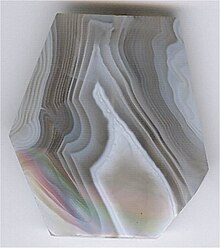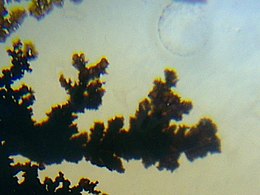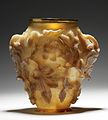Agate
| Agate | ||
|---|---|---|
Specific gravity 2.58–2.64 | | |
| Refractive index | 1.530–1.540 | |
| Birefringence | up to +0.004 (B-G) | |
| Pleochroism | Absent | |
Agate (
Etymology
The stone was given its name by
Formation and properties


Agate minerals have the tendency to form on or within pre-existing rocks, creating difficulties in accurately determining their time of formation.
The priming layer is often dark green, but can be modified by iron oxide resulting in a rust like appearance.[8] Agate is very durable, and is often found detached from its host matrix, which has eroded away. Once removed, the outer surface is usually pitted and rough from filling the cavity of its former matrix. Agates have also been found in sedimentary rocks,[6] normally in limestone or dolomite; these sedimentary rocks acquire cavities often from decomposed branches or other buried organic material. If silica-rich fluids are able to penetrate into these cavities agates can be formed.[6]
Types
Lace agate is a variety that exhibits a lace-like pattern with forms such as eyes, swirls, bands or zigzags. Blue lace agate is found in Africa and is especially hard.[10] Crazy lace agate, typically found in Mexico, is often brightly colored with a complex pattern, demonstrating randomized distribution of contour lines and circular droplets, scattered throughout the rock. The stone is typically coloured red and white but is also seen to exhibit yellow and grey combinations as well.[11]
Moss agate, as the name suggests, exhibits a moss-like pattern and is of a greenish colour. The coloration is not created by any vegetative growth, but rather through the mixture of chalcedony and oxidized iron hornblende. Dendritic agate also displays vegetative features, including fern-like patterns formed due to the presence of manganese and iron oxides.[12]
Turritella agate (
Coldwater agates, such as the Lake Michigan cloud agate, did not form under volcanic processes, but instead formed within the limestone and dolomite strata of marine origin. Like volcanic-origin agates, Coldwater agates formed from silica gels that lined pockets and seams within the bedrock. These agates are typically less colorful, with banded lines of grey and white chalcedony.[14]
Greek agate is a name given to pale white to tan colored agate found in the former Greek colony of Sicily as early as 400 BCE. The Greeks used it for making jewelry and beads.
Brazilian agate is found as sizable geodes of layered nodules. These occur in brownish tones inter-layered with white and gray. It is often dyed in various colors for ornamental purposes.
Polyhedroid agate forms in a flat-sided shape similar to a polyhedron. When sliced, it often shows a characteristic layering of concentric polygons. It has been suggested that growth is not crystallographically controlled but is due to the filling-in of spaces between pre-existing crystals which have since dissolved.
Iris agate is a finely-banded and usually colorless agate, that when thinly sliced, exhibits spectral decomposition of white light into its constituent colors, requiring 400 to up to 30,000 bands per inch.[15]
Other forms of agate include Holley blue agate (also spelled "Holly blue agate"), a rare dark blue ribbon agate found only near Holley, Oregon; Lake Superior agate; Carnelian agate (has reddish hues); Botswana agate; plume agate; condor agate; tube agate containing visible flow channels or pinhole-sized "tubes"; fortification agate with contrasting concentric banding reminiscent of defensive ditches and walls around ancient forts; Binghamite, a variety found only on the Cuyuna iron range (near Crosby) in Crow Wing County, Minnesota; fire agate showing an iridescent, internal flash or "fire", the result of a layer of clear agate over a layer of hydrothermally deposited hematite; Patuxent River stone, a red and yellow form of agate only found in Maryland; and enhydro agate, which contains tiny inclusions of water, sometimes with air bubbles.
Agate is a versatile gemstone that is often used in jewelry making. Agate is favored for its durability, with a Mohs scale hardness rating of 6.5–7. It is known for its colorful, banded patterns and wide range of hues. Agate is found in a wide range of colors, including shades of red, orange, yellow, green, blue, purple, and pink, as well as black and white. Agate is generally more affordable than other gemstones.
-
Agatized coral
-
Dendritic agate
-
"Turritella agate" (Elimia tenera)
-
Crazy lace agate
Uses

Agate is one of the most common materials used in the art of
The decorative arts use it to make ornaments such as
Industrial uses of agate exploit its hardness, ability to retain a highly polished surface finish and resistance to chemical attack. It has traditionally been used to make knife-edge bearings for
-
A 6.8 kg (15 lb) barrel full of tumble-polished agate and jasper
-
Gold Roman signet ring with portrait of emperor Commodus in niccolo agate, 180-200 CE, found in Tongeren, Gallo-Roman Museum (Tongeren)
-
The "Rubens Vase" (Byzantine Empire). Carved in high relief from a single piece of agate, most likely created in an imperial workshop for a Byzantine emperor.
-
Victorian banded agate earrings
-
Maryland Agate - Cut and illuminated to show internal structures
Health impact
Respiratory diseases such as
See also
- Amber
- Amethyst
- Aqeeq
- Aquamarine
- Citrine
- Diamond
- Emerald
- Garnet
- Geode
- Kyanite
- Labradorite
- List of minerals – List of minerals with Wikipedia articles
- Lithophysa
- Moonstone
- Opal
- Peridot
- Rose Quartz
- Swiss Blue Topaz
- Thunderegg
- Tiger's Eye
- Topaz
- Tourmaline
- Turquoise
Citations
- ISSN 0016-7037.
- ^ "Masterpiece of Greek Art Found in the Griffin Warrior Tomb". Smithsonian. Smithsonian Institution. 7 November 2017.
- ^ "Agate Creek Agate". Archived from the original on 16 July 2007. Retrieved 2007-07-01.
- ^ "Achates". Archived from the original on 26 August 2023. Retrieved 19 September 2014.
- ^ "Agate: Mineral information, data and localities". www.mindat.org. Archived from the original on 2020-02-15. Retrieved 2020-02-11.
- ^ from the original on March 13, 2022. Retrieved October 1, 2006.
- ^ Walger, Eckart; Mattheß, Georg; von Seckendorff, Volker; Liebau, Friedrich (August 2009). "The formation of agate structures: models for silica transport, agate layer accretion, and for flow patterns and flow regimes in infiltration channels". www.ingentaconnect.com. Archived from the original on June 4, 2018. Retrieved March 3, 2020.
- ^ a b "Metaphysical Properties of Yellow Skin Agate - Stone Treasures". Stone Treasures by the Lake. 24 March 2019. Archived from the original on 2020-02-26. Retrieved 2020-02-27.
- ^ "Agate chalcedony: The mineral Agate information and pictures". www.minerals.net. Archived from the original on 2020-03-16. Retrieved 2020-02-27.
- ISBN 978-1-55643-668-0. Archivedfrom the original on 2023-08-26. Retrieved 2020-10-29.
- ISBN 978-0-7631-8189-5. Archivedfrom the original on 2023-08-26. Retrieved 2020-10-29.
- ISBN 978-1-4027-6829-3. Archivedfrom the original on 2023-08-26. Retrieved 2020-10-29.
- ISBN 978-0-7387-4844-3. Archivedfrom the original on 2023-08-26. Retrieved 2020-10-29.
- ISBN 978-1-60938-014-4. Archivedfrom the original on 2023-08-26. Retrieved 2020-10-29.
- ^ "Iris Agate". Archived from the original on 2022-07-01. Retrieved 2022-05-27.
- ^ C. Michael Hogan. 2007. Knossos fieldnotes, Modern Antiquarian Archived 2018-07-11 at the Wayback Machine
- ^ "Background Article on Idar Oberstein". Archived from the original on 2008-12-23. Retrieved 2008-11-27.
- ^ "Agate Windows - Community Presbyterian Church". Archived from the original on 1 March 2012. Retrieved 19 September 2014.
- PMID 22345906.
- PMID 11439400.
- PMID 21461160.
General and cited references
- Cross, Brad L. and Zeitner, June Culp. Geodes: Nature's Treasures. Bardwin Park, Calif.: Gem Guides Book Co. 2005.
- Hart, Gilbert "The Nomenclature of Silica", American Mineralogist, Volume 12, pages 383–395, 1927
- International Colored Gemstone Association, "Agate: banded beauty"
- "Agate", Mindat.org, Hudson Institute of Mineralogy
- Moxon, Terry. Agate: Microstructure and Possible Origin. Doncaster, S. Yorks, UK: Terra Publications, 1996.
- Pabian, Roger, et al. Agates: Treasures of the Earth. Buffalo, New York: Firefly Books, 2006.
- Schumann, Walter. Gemstones of the World. 3rd edition. New York: Sterling, 2006.
External links
- "Agates", School of Natural Resources, University of Nebraska-Lincoln (retrieved 27 December 2014).









